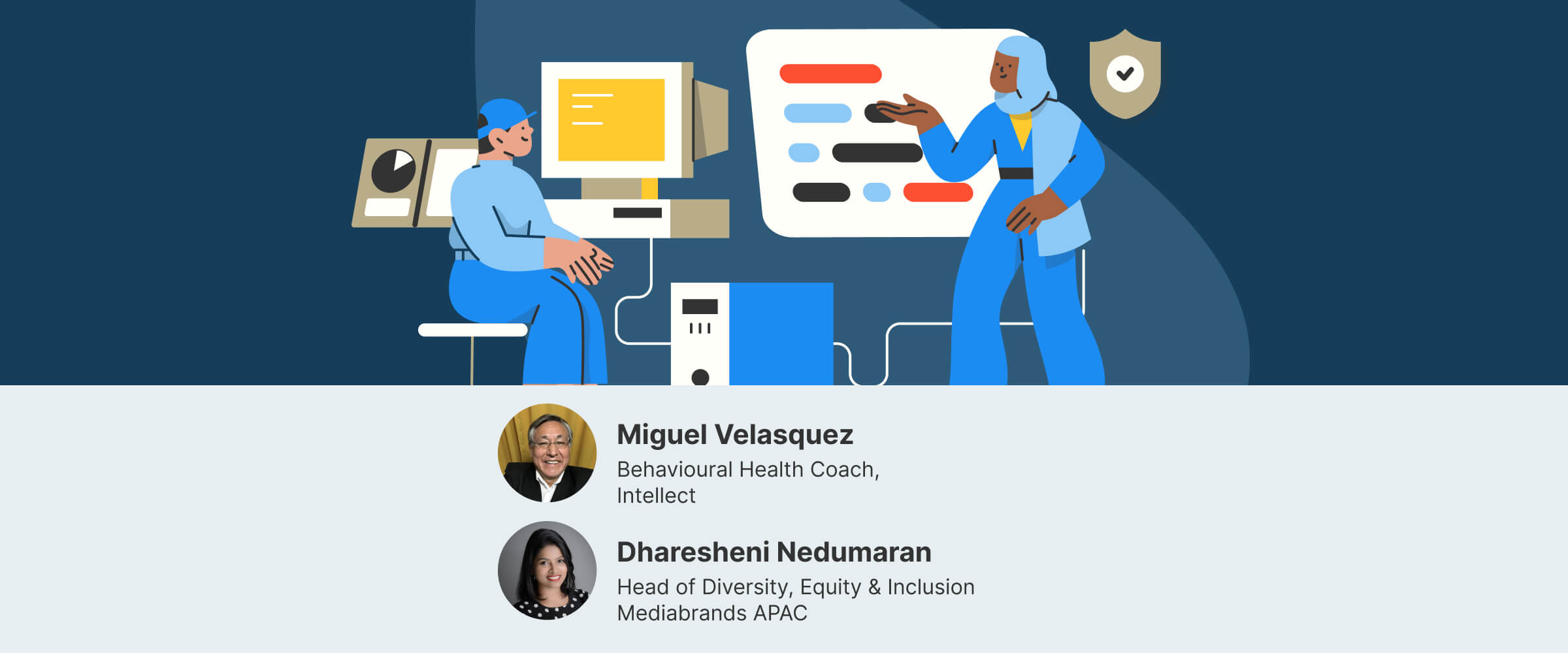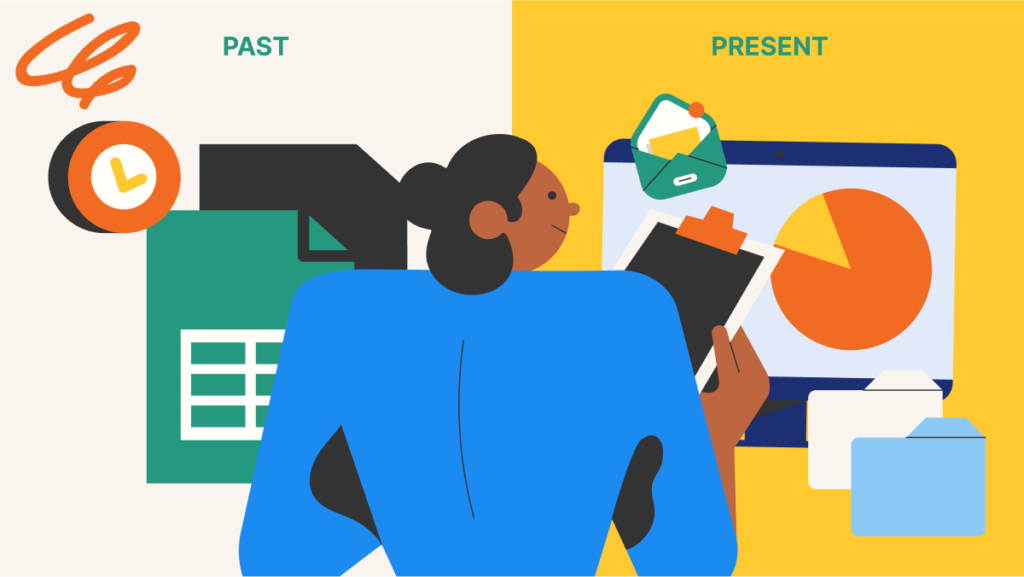Understanding DEI at first glance may seem as straightforward as its acronym suggests. While we cognitively accept that different people face different challenges, it isn’t a simple organisational task that has a formula fit for all. In fact, 3 in 5 employees in Singapore find DEI efforts in their workplaces inadequate. (Learn more about the DEI landscape in Asia here.)
To understand how organisations can boost systemic DEI, Intellect invited Dharesheni Nedumaran, Head of Diversity, Equity, and Inclusion at Mediabrands APAC, and Behavioral Health Coach (ICF) Miguel Angel Velasquez Campos, to a fireside chat entitled “DEI in Asia: Fostering Inclusivity in the Workplace.“

What is DEI?
To start things off, Dharesheni explained the interconnectedness of the three principles that comprise DEI, along with the importance of its shared synergy:
Diversity can be promoted by recognising that differences can be strengths and seeing employees as individuals without defaulting to stereotypes. It encompasses race, gender, neurodivergence, orientation, abilities, and many more.
Inclusion is present when these employees feel safe enough to bring their differences to the table. This only happens when employees feel like they belong to the workplace and are valued members of its community.
Equity is the extent to which employees have equal access to resources. Organisations have different starting points, but meeting the different needs of their workforce remains an ongoing effort.
“If the world were a fair place, our workplaces and leadership teams would be diverse and people wouldn’t feel the need to hide their differences. But we’re just not there yet,” Dharesheni said, outlining the fundamental pillars of a DEI strategy.
The people we hire: Selecting a diverse range of individuals to join our teams.
The business we conduct: Considering how our business practices influence both society and the community.
The work we do with our people: Ensuring inclusivity in every aspect of our engagement, irrespective of their backgrounds.
The products and services we offer: Understanding how these impact and interact within the larger context.
How to improve systemic DEI
1. Familiarise with individual markets
One common pitfall that organisations often encounter is implementing a singular solution across all global markets. Dharesheni, who collaborates with teams throughout APAC, underscores that definitions of diversity, marginalised communities, and mental health may vary across regions, on top of the existing differences in workplace cultures.
For instance, while the United Nations and Malaysia consider mental health as a mental disability, this perspective differs in Singapore. Therefore, when introducing a program for Persons with Disabilities (PWDs), she has to consider how it may be perceived differently.
2. System first, people second
Rather than solely concentrating on individual behaviours, changing ingrained organisational systems has a much larger impact. A pertinent example is ensuring that insurance policies are equitable for all partners – a systemic change that yields lasting results. No doubt, it’s more challenging, but outcomes are more sustainable.
According to Dharesheni, there’s a recent trend of sending employees for unconscious bias training, with Starbucks notably closing its entire office for a 4-hour session. But an excessive emphasis on employees has its drawbacks.
“People are one of the barriers, but we focus too much on that sometimes, which makes us feel really defensive,” she remarked.
3. Coach leaders at the top
Miguel explained that the effectiveness of DEI policies hinges on business leaders’ ability to internalise them. Leaders may possess knowledge, but fall short as these principles have yet to become second nature. (How inclusive are your company leaders? Take this quiz to find out.)
“The system is part of the culture and the culture is a result of daily interactions. If you don’t assess how the people are interacting, it’s going to be hard to change (the system),” Miguel emphasised.

How does one unlearn decades’ worth of behaviours? Miguel’s answer lies in change management. When coaching executives, he adopts the ADKR framework: Awareness, Desire, Knowledge, Reinforcement. During coaching sessions, leaders are encouraged to introspect, align their values, and reevaluate how these align with both company values and DEI principles.
Throughout this process, leaders also adopt and ultimately exemplify inclusive language. This not only minimises microaggressions in the workplace, but it also encourages employees to open up about the support they need. On that note, Miguel also coaches his clients in nonviolent communication (NVC), helping executives communicate from a place of personal need rather than position.
“Express your true needs in a way that (makes) the other person feel receptive. Those needs will invite other people to help you,” he shared.
Asked what they would do as a leader to improve systemic DEI, participants of the webinar suggested the following:
- Advocate for more inclusive policy-making
- Incorporate DEI into mandatory L&D training.
- Share personal lived experiences.
- Raise awareness by organising discussions about DEI.
- Establish safe spaces to encourage meaningful conversations.
- Pose questions and listen actively to employees.
Measuring the impact
1. Define your objectives
Remember, every market is unique and organisations may tailor DEI goals and metrics accordingly. These objectives might encompass representation, the concept of inclusion, or the demographics of employees leaving the company. How many women are there? Are any of them new parents?
In Miguel’s line of work, a creative approach involves getting executives to devise their own metrics and goals. This allows room for adjustment as they go along and fosters a sense of accountability for their progress.
2. Collect relevant data
As senior management implements change, the HR department can pinpoint touch points to gauge its efficacy. An encompassing data collection framework may involve conducting pulse surveys to measure engagement, performing exit interviews, administering questionnaires about employees’ sense of belonging, encouraging informal feedback, and even soliciting anonymous responses.
That being said some goals can be hard to track, caveated Dharesheni. Organisations have differing levels of psychological safety, and employees may not always feel safe enough to disclose their needs. However, she suggested starting early and sustaining monitoring efforts over time. Employees who currently choose to respond as “prefer not to say” might feel more comfortable sharing their answers two years down the line, signifying progress in itself.

3. Identify personal biases
How can company leaders make sense of the data collected? When coaching high-ranking executives, Miguel helps them to analyse metrics such as recruitment, promotion, and retention, identify personal biases, and correct their actions right away. But this isn’t always a walk in the park, Miguel confessed.
“Ideally, they should be touched by empathy as soon as they see that metrics are low. Unfortunately, sometimes, it’s very difficult to touch the hearts of these executives because they’re very number-oriented,” he said.
In this scenario, taking an economic perspective is more effective than appealing to their sense of empathy. Miguel does this by encouraging executives to assess how gaps in systemic DEI can be detrimental to the business’s ecosystem. This exercise goes beyond the organisation and its employees, encouraging executives to detect bias when liaising with vendors, suppliers, and even users.
Take the first step today
Dhareshini likened systemic DEI work to a standing ovation. It takes one courageous person to stand up and applaud before the rest of the audience joins them. There will always be people who don’t but eventually have to because they can’t see the stage anymore.
Likewise, it takes one advocate for other stakeholders to buy in. Still others will catch on at a later time, and that’s okay because we all have different starting points. But one day, negligence of systemic DEI will be the exception, not the rule, and sitting it out will cease to be comfortable or acceptable.
Book a demo here and start coaching your executives today.








